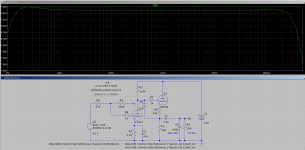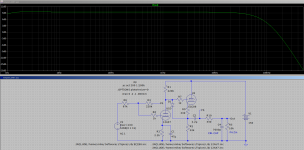On a buffered P-G FB arrangement like this is there any danger of negative interactions with the load (amp input) due to the FB source not being isolated from the load by the output cap? It would seem to be safe unless something is seriously wrong with the power amp input.
Also when using a hot rod tube like the ECC88 as a CF is it a good idea to use an anode stopper to dampen naughty behavior with the power supply rail?
P.S. As an aside I am surprised at how well this simulates even with the rather low B+. If the load cap gets to 5000p it shows a 6dB ultrasonic bump right before roll off but more reasonable loads look really nice. Even with output swing of 9V peak it simulates quite reasonable HD and when limited to a few volts peak the HD looks beautiful. A higher B+ is desireable of course but I was surprised that an AX7 looked as good as it did at only 150V.

Also when using a hot rod tube like the ECC88 as a CF is it a good idea to use an anode stopper to dampen naughty behavior with the power supply rail?
P.S. As an aside I am surprised at how well this simulates even with the rather low B+. If the load cap gets to 5000p it shows a 6dB ultrasonic bump right before roll off but more reasonable loads look really nice. Even with output swing of 9V peak it simulates quite reasonable HD and when limited to a few volts peak the HD looks beautiful. A higher B+ is desireable of course but I was surprised that an AX7 looked as good as it did at only 150V.
Attachments
A cathode stop, as you have included, is more effective in practical situations than an anode stop. For very large capacitive loads, you may want to include an additional "build-out" resistor (series resistor between the point of feedback takeoff and output jack) of a few hundred Ohms.
The subsonic bump you see is from the finite output coupling cap.
All good fortune,
Chris
The subsonic bump you see is from the finite output coupling cap.
All good fortune,
Chris
The subsonic bump you see is from the finite output coupling cap.
What's the cause of it? Is adding a series resistor the best way to tame the bump? I have similar bump from a line preamp of similar circuit, no global feedback though, cap comes out of cathode follower with no series resistor.
Yeah, you would think on first blush, that a single low frequency pole should be unconditionally stable, especially with LTspice's assumption of a perfect power supply. I'd interpret it as a phase lead affecting both output and feedback, possibly with a tiny contribution from the cathode bypass capacitor. Someone more Spice-savvy could possibly give a better description.
An output build-out resistor normally has no effect on low frequencies, but a cathode stop is a good idea for all cathode followers for very high frequency stability reasons. Too often overlooked, but VHF stability often is.
All good fortune,
Chris
An output build-out resistor normally has no effect on low frequencies, but a cathode stop is a good idea for all cathode followers for very high frequency stability reasons. Too often overlooked, but VHF stability often is.
All good fortune,
Chris
What's the cause of it? Is adding a series resistor the best way to tame the bump? I have similar bump from a line preamp of similar circuit, no global feedback though, cap comes out of cathode follower with no series resistor.
There are a couple of things going on here at the same time which might be confusing things. there is a slight infrasonic bump due to the feedback not going all the way to DC (coupling cap) and the ultrasonic bump which was much larger. That one does seem to be tamed/eliminated with the buildout resistor.
I presume that if you are driving two sets of output jacks that each jack should get its own resistor.
In tube feedback circuits that are sensitive to capacitive loading like this, I have had good luck using ferrite beads. You probably don't need something like that here for a preamp, but it works where adding the series resistance might be unacceptable, like in a power tube stage.
I guess the air-core inductor in a solid-state amp plays the same role, but I've never tried that in a tube circuit. I've seen those plate stopper resistors with wire wound around them for a parallel inductor in some RF circuits.
But if a plain resistor doesn't raise Zout above what is acceptable for the circuit, that is the simplest.
I guess the air-core inductor in a solid-state amp plays the same role, but I've never tried that in a tube circuit. I've seen those plate stopper resistors with wire wound around them for a parallel inductor in some RF circuits.
But if a plain resistor doesn't raise Zout above what is acceptable for the circuit, that is the simplest.
- Home
- Amplifiers
- Tubes / Valves
- FB from output (preamp) and anode stoppers

